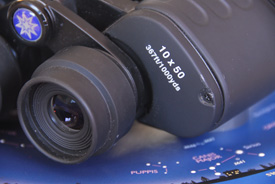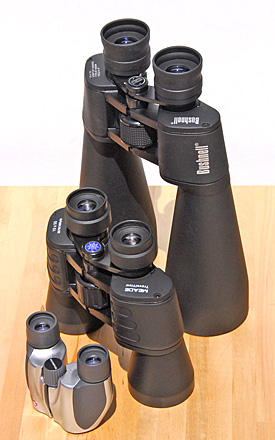
A bewildering assortment of binoculars awaits at your local camera store. But when it comes to stargazing, some binos are better than others.
Binoculars come in a dazzling variety of magnifications and sizes. Many stargazers recommend 10×50s — binoculars that magnify 10× and have 50-millimeter-diameter objective lenses. A trip to your local camera store will likely show you a bewildering array of additional choices. You’ll see 15×70s, 8×40s, 7×35s, and so on. But how do we decide which combination of magnification and aperture is best for stargazing?
Relative Goodness

As I described in Binoculars by the Numbers, binoculars can be characterized by several specifications. In general, the visibility of clusters, nebulas, and galaxies improves as the magnification goes up. Improvement also occurs when we harness the extra light gathering power of bigger objective lenses. Is one factor more important than the other? Let’s say we’re looking at a pair of 10×42s and some equally nice 7×50s. Which would be the better choice for astronomy? Most observers find that increasing the magnification makes up for a slight difference in light gathering, but is an increase of 7× to 10× enough to compensate for a 8mm aperture difference?
Over the years a number of schemes have emerged to weigh the relative merits of various magnification and aperture combinations. One of the oldest is the “relative brightness index.” To calculate this, you divide the aperture by the magnification, and then square the result. In this system 7×50s would rate 51, and 10×42s, a relatively poor 18. In reality, this index simply restates the “biggest exit pupil for a given aperture is best” argument, which as noted in this article, doesn’t necessarily hold true for stargazing.
Meet Mr. Bishop

One of the first to attempt to quantify binocular differences specifically for stargazing was Roy Bishop, former editor of the Royal Astronomical Society of Canada’s highly respected Observer’s Handbook. In his article on binoculars Bishop lays out his “visibility factor.” It’s easy to use since you merely multiply the magnification by the aperture, just like the numbers on the back of the binoculars suggest. In Bishop’s scheme, 7×50s would rate 350 while 10×42s would score 420, making them the better choice.
In my experience, Bishop’s rule of thumb holds up well in the real world. For example, I own a pair of Canon 15×45 image-stabilized binoculars and some high-quality 10×50s. The 15× Canon binoculars are significantly better at showing deep-sky objects. This is as predicted by Bishop’s visibility factor where the Canons outrank the 10×50s by a score of 675 to 500.
Certainly, the simplicity of Bishop’s formula makes it very easy to use. But is it the last word on the subject? Not necessarily.
Adler’s Approach
In 2002, a dedicated binocular observer and inventor named Alan Adler wrote an article entitled “Some Thoughts on Choosing and Using Binoculars for Astronomy,” which appeared in the September issue of Sky & Telescope. Based on his vast observing experience and years of comparing different binoculars, Adler concluded that Bishop’s formula failed to give enough weight to the magnification side of the coin. To remedy this, Adler proposed his own performance index, in which you multiply the magnification times the square root of the objective lens diameter. Using Adler’s formula, 7×50s rate 49, while 10×42s score higher, at 65 — agreeing with the conclusion reached by using the Bishop index.
But the Bishop and Adler systems don’t always yield the same results. For example, Bishop’s simpler formula rates 15×70s higher than 18×50s, while these binoculars score the same with Adler’s index. Having tested both binoculars, I would say that Adler’s is more accurate since I found the 18×50s every bit as good as my 15×70s, though clearly other factors (such as optical quality) come into play.
So which index is best? Bishop’s has the advantage of being simple enough that you can do the arithmetic in your head, but in my experience, the Adler system more realistically reflects the differences between binocular models. One thing’s for sure — both give a much better idea of the relative performance of different binoculars than the relative brightness index.
Finally, it’s worth noting that it’s the nature of rules of thumb that exceptions will exist. The Adler and Bishop indexes exist in a universe where the phrase “all other things being equal” applies. Obviously, we don’t really live in that universe! Rules of thumb are meant to guide you in a general direction, so if you’ve narrowed your choice down to a couple of individual models, do your best to test them out under the night sky. There’s no substitute for actually holding binoculars in your hands and trying them.
Did you find this article interesting or helpful? If so, consider using this link the next time you shop at Amazon.com. Better yet, bookmark it for future use. Thanks to Amazon’s associates program, doing so costs you nothing yet helps keep this site up and running. Thanks!
